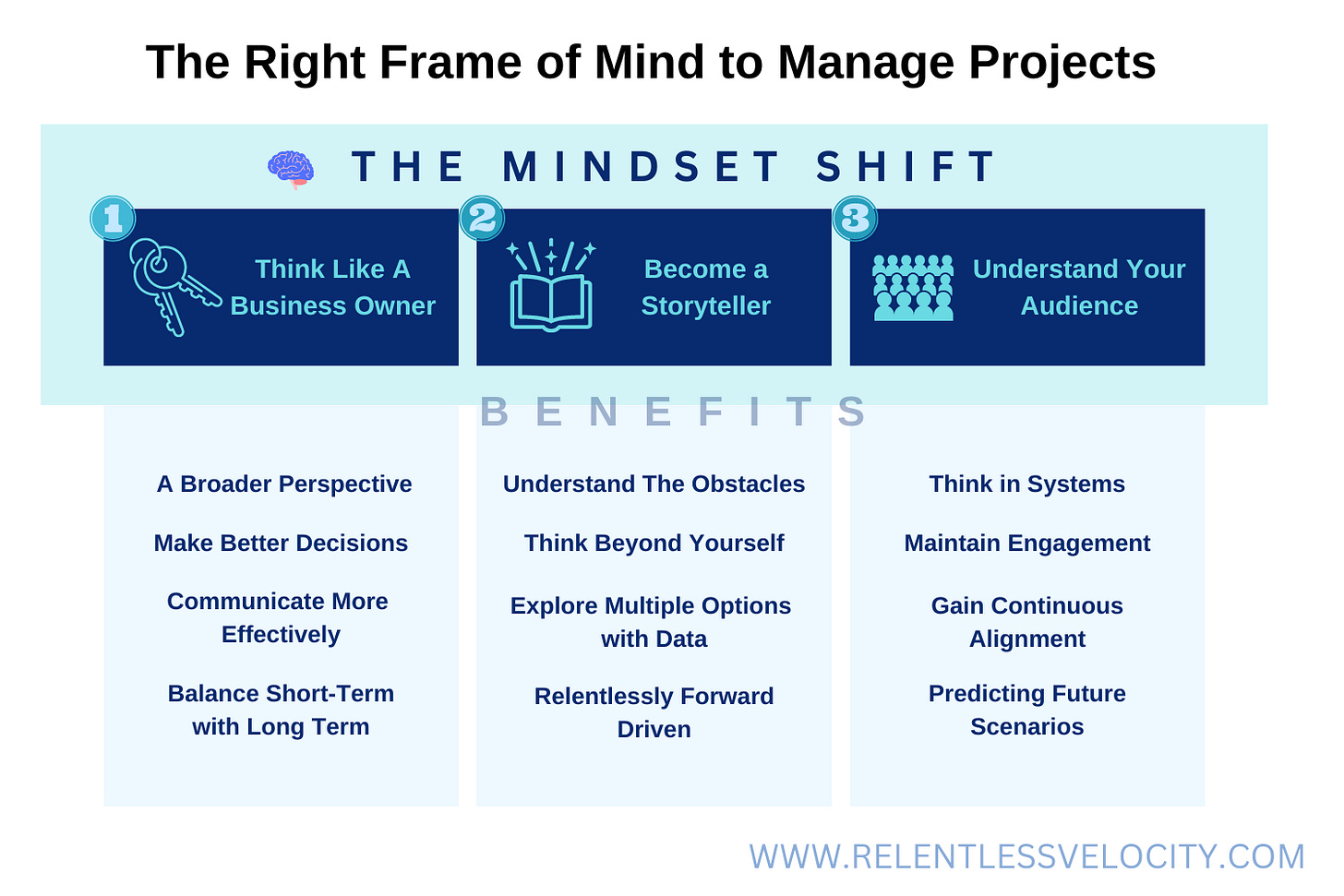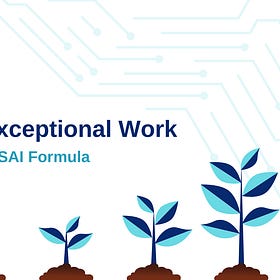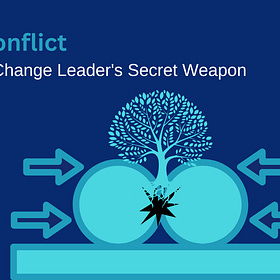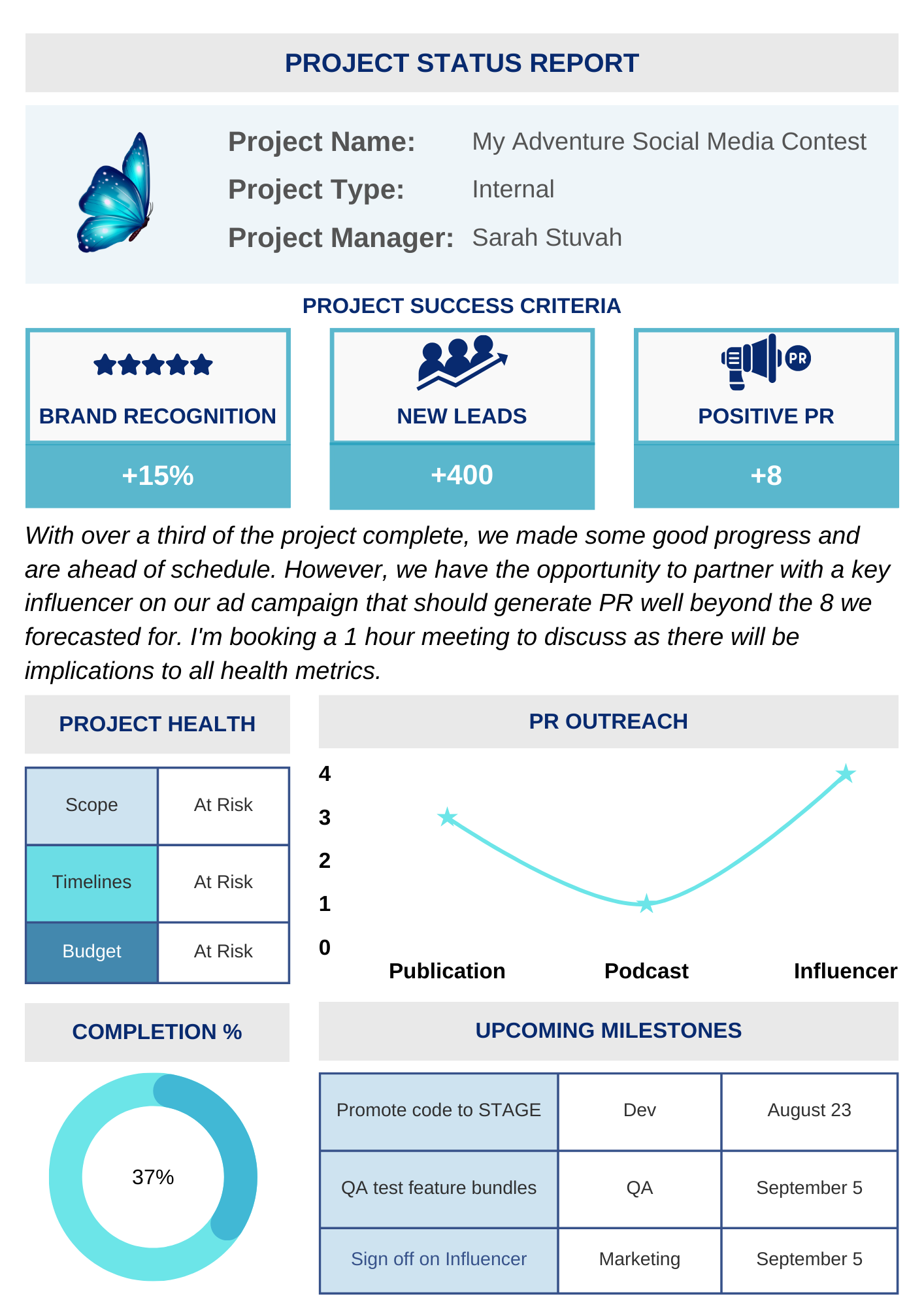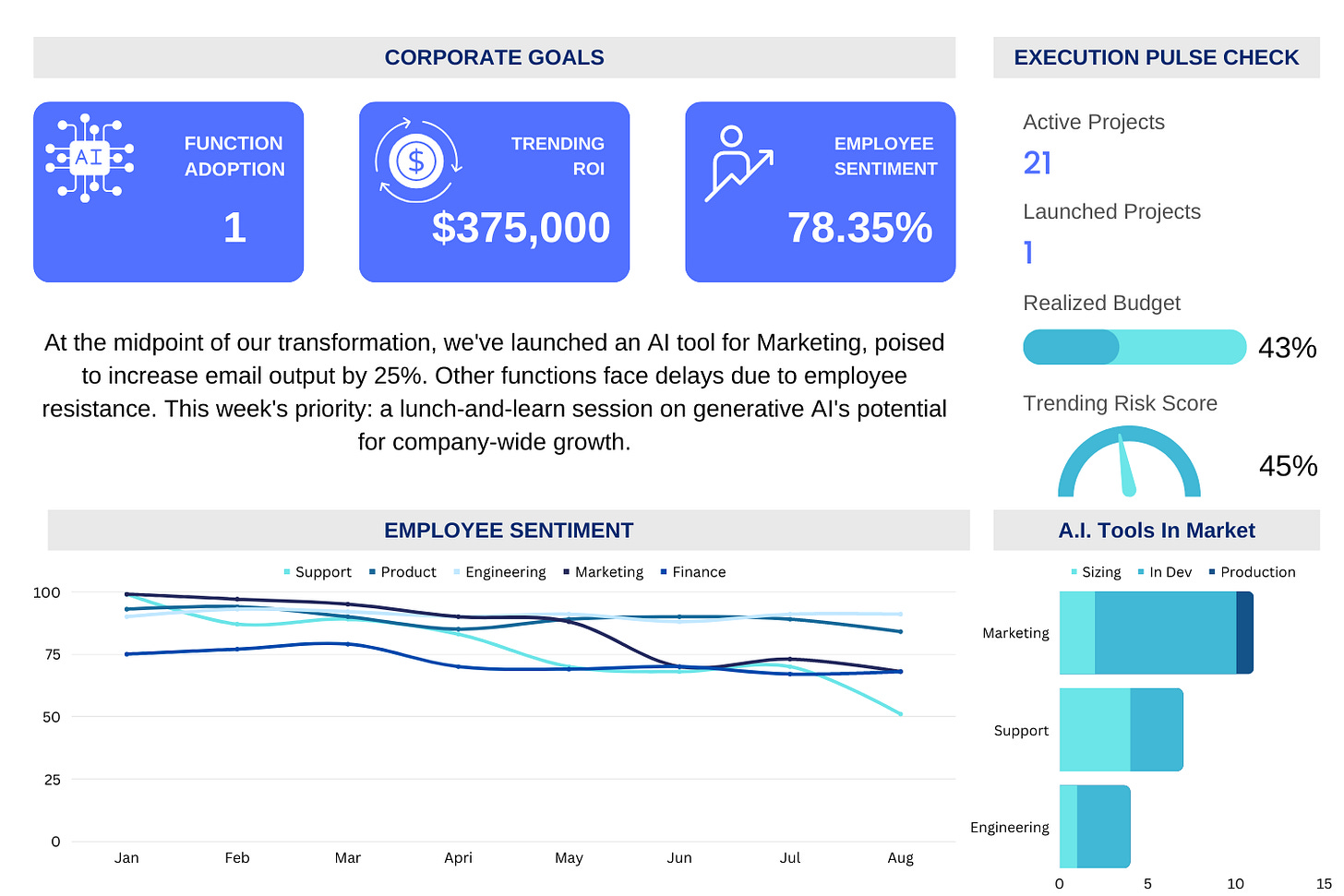Driving Success with Status Reports: How to Communicate Like a Pro
(#012)
Dear Subscribers,
In today's article, we're exploring a communication essential: the status report. I've searched extensively for an in-depth guide on how to craft an exceptional one, but sadly, none hit the mark. With this guide, I aim to fill that gap and establish it as the ultimate resource for producing top-tier status reports for every business leader.
If you’re new here, or received this email from a friend or colleague, I write articles such as this every other Monday. Subscribe for free so you never miss out.
Let's jump into the article.
As project and change leaders, one of the first skills we're often told to master is communication. The ability to speak effectively in front of others, clearly provide accurate and timely information to stakeholders, and capture data through active listening are all crucial components of a project leader who knows how to communicate.
Where we're truly put to the test is through status reports. Among project management tools, none achieve such widespread use yet offer so few best practices for approach, execution, and output. Several reasons contribute to this, and most of them are valid:
Project managers infuse their own unique skills, experiences, and values into the mix.
The company may have specific guidelines and governance structures that influence the tools used for reporting.
The project in question may call for specific details for inclusion into the status report.
Clients, sponsors, or key stakeholders may have particular requirements regarding information and format.
Even with these points having merit, it’s striking to me how bad many working professionals are in creating something effective, engaging and built to succeed. Yes, we need to continue to be dynamic in how we approach status reports, but the underlying structure of it all needs a revamp.
I have prepared over 100 status reports and reviewed countless more from the teams I've managed. I believe there is a discernible pattern of what works and what doesn't. Interestingly, most of the issues with poorly performing status reports have little to do with the reports themselves. In my opinion, everything starts with how we approach projects and the way we manage them. So that’s what we’ll start with.
🧠 Part 1: Having The Right Mindset
Many project professionals understand what they’re required to do from a roles and responsibilities point of view. Specifically, the need to grasp a host of technical skills (managing timelines, identifying risks, building scope, etc.) as well as the intangibles (dealing with conflict, communication, etc.). But what they sometimes miss is the extra layer that goes beyond these skills.
This top layer acts like a compass, guiding how project professionals use their combined technical and soft skills to lead.
This top layer consists of 3 parts. Each part is of equal importance but in my opinion, should be focused on in a systematic way, so this is how I’m going to explain it in this deep-dive.
Think Like A Business Owner
I like to view the projects and programs under my belt as individual micro-businesses. Each of them has a client (or sponsor in some cases) and stakeholders who have a vested interest in what we’re building, either throughout the project or after the benefits are realized. There are financial components to most projects, and the need for budget management is crucial to ensure we continuously stay in the black. The list goes on.
As the project leader, I act as the CEO of this "business" and am ultimately responsible for ensuring its success.
By adopting the mindset that your projects are businesses and you are the business owner, you set in motion several subconscious factors that project professionals who don't take this approach lack in their arsenal.
You start seeing things from a broader perspective. You realize that risks can emerge from unexpected places, and achieving success isn't solely about meeting scope, quality, and budget requirements.
You make better decisions, rooted in a comprehensive understanding of various perspectives and areas.
The tone of your communication is more precise and effective. You feel confident in knowing when to apply pressure and create urgency when the need arises.
Most importantly, with a business owner’s mindset, you balance the needs of the project or program by considering both short-term and long-term outcomes. A far cry from traditional project leaders grounded just in short-term thinking.
Is this an easy one to pick up? Definitely not. However, it's a mindset that, once mastered, enhances all your work outputs and aligns them better with company goals rather than surface-level objectives. If you want to learn more about producing exceptional output, check out my earlier deep-dive here:
SAI: The Formula For Exceptional Work
Discover the essential, up-and-coming skills required for future project managers, people leaders, and operators by subscribing below. Join readers that span over 20 countries and counting.
Become A Compelling Storyteller
If you were to reflect on the content you've come across during your recent professional journey, you might notice that a good chunk of it falls into the "just okay" category. Whether it's sifting through work presentations, going through status reports, or reading email updates, it's pretty common to find things that are a bit confusing and not very engaging. They don't always seem fully thought out and don't flow quite as smoothly as they could.
If you're lucky, you'll find a few pieces of content that really stand out in a positive way, contrasting with the less engaging material you endlessly sifted through.
I’m willing to bet that the great content you find, regardless if it was a presentation or something written, told a compelling narrative.
This takes us to our next mindset shift. Learning how to communicate like a storyteller that goes through the motions and bring their audience along for the ride the entire way.
Why is this important? Learning the skills of the storyteller will ensure a few key benefits.
It allows you to clearly articulate the challenges ahead. Pairing your newly acquired business owners mindset to first identify the right obstacles with the ability to explain these upcoming challenges, you're essentially offering a sneak peek into the future – a powerful move when done right.
A good storyteller knows their audience well. Project and change leaders shouldn't create content for themselves. Instead, we're like narrators, sharing what teams need to know, along with practical insights that bring everyone together.
A skilled storyteller emphasizes the journey and the array of choices, where decisions come into play. From a project leader point of view, our knack for exploring and conveying risks, challenges, and data-backed solutions is vital for bringing everything together towards a successful outcome.
Every story finds its fulfillment in an ending. Even though your completion date might seem distant, it's never too early to start envisioning the world that will define that moment. By outlining the steps to shape this envisioned future, you pave the way for a more accurate anticipation of what's to come, resulting in a much more unified team as a result.
It goes without saying that thinking like a business owner is just one piece of the puzzle. When you combine that entrepreneurial mindset with the power to communicate through compelling stories, you'll position yourself ahead of 90% of other project and change professionals. It's not just about understanding the business; it's about crafting narratives that resonate.
We’re not done yet. There’s one more mindset shift we need to work on before diving into the status report itself. Let’s get to it.
Understanding Your Audience
If you’ve been reading my newsletter for awhile now, you will know I’m big on two things.
Understanding company strategy
Understanding your stakeholders
Number 1 is covered quite well if you adopted the mindset of thinking like an owner. Now it’s time to tackle number 2.
It's easy to imagine your audience as a group who all share a common interest, watching your project or change initiative unfold with a hopeful outcome.
While there's some truth to this, it's just the surface. Your audience is made up of individuals, and we all know how diverse human nature can be. Each person has their own evolving hopes, dreams, and desires.
When you factor in the work dynamic, things get even more intricate. The professional environment adds a new layer of complexity to consider.
Each function within an organization has their own goals and objectives that roll up into the larger strategy of the company.
If the above statement is true, and I believe in most cases it is, thinking of your audience as a whole is the wrong approach to take.
Instead, your audience should be segmented into like-minded components, facilitating personalized and relevant communication. Just as a marketing professional creates personas for their ideal customers, project professionals should also examine their audience in a similar manner.
Looking at your initiative and the audience associated with it, you will want to spend some time examining how best to segment them. Some ideas are:
Impact - Which audience members play the biggest roles in your project and which are more low key on the impact scale?
Influence - Who of your group of stakeholders will be massive cheerleaders for your initiative and which will be detractors? Adding another lens, how likely are they to transition other stakeholders to share that same mindset?
Interest - Do some of your stakeholders really love what your team is creating? And are there others who just aren't as interested? People's feelings toward your project can vary widely, like different colors on a canvas.
Fear Index - This happens to be one of my personal favorites, particularly when it comes to business transformation projects. Are there stakeholders who might be feeling a bit apprehensive about the upcoming changes? And conversely, do you have team members who are wholeheartedly championing this change?
Function - The most fundamental segmentation level involves grouping stakeholders by their functions. Are there any notable disparities when examining one function against another?
Skill Set - Maybe your project calls for multiple sets of skills that are hard to come by. Are there specific capabilities or experiences amongst your stakeholder group that need to be catered a specific way?
After crafting several sets of segments, the real magic happens when you combine two of them into a matrix. This lets you explore new and unexpected scenarios, almost like stepping into the shoes of a fortune teller.
I describe the matrix format in greater detail in this article:
Conflict: A Change Leader's Secret Weapon
In 2017, I was entrusted with leading one of the most ambitious projects in our company's history: the migration of all our clients' solutions to the next iteration of our platform. This was a high-stakes initiative with stakeholders across the globe and at all levels of the organization.
Adopting all three elements (and getting great at them) is when the true mindset shift happens. Your ability to tackle problems, communicate and execute on strategies should drastically improve from here on out.
Now that we’re in the right frame of mind, we still have to do something about those mediocre status reports we’ve been dishing out. So let’s focus on that next.
📊 Part 2: The Next Level Status Report
The project status report, as I see it, serves as a crucial instrument that drives the project forward. While it's true that generative AI is on the horizon, and there may be a time in the foreseeable future when artificial intelligence will accurately create and distribute such documents, we haven't arrived at that point just yet. Even so, when that moment does arrive, the underlying approach to composing and distributing such reports will continue to hold significance for diverse human endeavours.
The rationale for this is quite simple when you go to the core of what the status report really is.
The status report is an actionable tool that brings to light progress towards company strategy.
That’s all there really is to it. All the details that go into this report should serve this purpose.
Where Professionals Go Wrong
It’s safe to say that most status reports don’t accomplish what they set out to do. And from my experience, these are the main reasons behind it.
Low Value Success Metrics: Many status reports focus on traditional project measures like comparing cost and budgets to initial plans. While these are important, they don't always show how well we're moving toward the company's bigger goals.
The Amount of Data: Depending on who's reading them, most status reports have too much detail or not enough. It's crucial to find the right balance.
Sharing Outdated Insights: Status reports that only talk about things that have already happened don't give us much to work with for the future. We need reports that help us take action now.
Lack Direction: Many status reports of today are just a random set of data and commentary without any flow to it. This is one of the most common reasons status reports often get ignored after a quick look.
Is The Opposite of Transparent: As someone who’s leading a new initiative, it’s your job to bring to light the good and the bad to enable proactive problem solving. Poor status reports are often full of fear or fulfilling political agenda’s which hurt the project and the company long term.
With the above in mind, here's your top priority: Go through your old and current reports and check to see if any of these problems are present. Don’t worry, it happens to the best of us. If any of them are more than a one-off, fix or remove them going forward. Your reports might end up looking simple and lean, but it will have the most important and value info.
Next Level Status Reports
I mentioned this before, but let's highlight it again: status reports must remain adaptable, tailored to the company's culture, project specifics, and even the project manager's style. I really value creativity, and that won't change. Yet, we want to build a structure to lift how good a status report can be. Considering this, a few key things are a must for a strong status report. To be precise, there are six of these important parts.
A North Star: Specifically, what is the company trying to achieve and what are its benchmarks? Pay careful attention here. By North Star, I’m not talking about project goals. Projects, once completed should contribute to the north star. The north star can be a statement or presented as forecasted metrics/big rocks.
Executive Summary: I like this term as it puts you in the mindset of the business owner with the status report as a version of your shareholder report. The executive summary should be brief and list only the important elements between the previous report and the current one. Topics such as an update on progress, the introduction of a new threat or a change in the way things are done are usually value added ones.
Project/Program KPIs: The goal is to have a very clear grasp of the project success criteria and how do these roll up into the north star for the company. For example if the in-year goal of the company is to bring an additional $10 million in project revenue from new customers, we can measure this in different ways through the lens of our project. Think about speed – the faster we work, the more projects we can handle. Or consider client satisfaction via a sentiment score – nailing the current project might convince a key client to bring more lucrative projects our way. As you can see, there's a lot to track that goes beyond just the Project Management Office, catching the interest of various stakeholders.
Leading Indicators: Building on project/program KPIs, leading indicators are powerful because they bring potential opportunities or risks to light before they fully materialize. This means you can address them proactively, raising awareness and taking action sooner. That sentiment score I just mentioned? It can be viewed as a valuable leading indicator. If your client isn't satisfied with the project's progress, it doesn't just affect long-term revenue; short-term gains are at stake too! By utilizing the status report, you can swiftly regroup and tackle these issues in their early stages.
Key Milestones: Often, professionals overload their status reports with excessive details when a simple and clear roadmap would suffice. When you consider your initiative in its entirety, what are the essential upcoming milestones that your audience must know, plan for and agree upon? A status report can offer this insight without drowning everyone in unnecessary information.
Clear Visibility & Accountability: Imagine your status report as a triple-duty tool: a roadmap, compass, and fortune-teller, all in one. Every part of your report, from charts to the executive summary, should do more than share current progress; it should seamlessly blend in predictive insights. Even better, it needs to spotlight who's in charge of what, and here's why it's golden: first, it guides those responsible, outlining their tasks and deadlines. Second, it keeps everyone else in the loop about the team's roles. Especially for extensive projects, a status report becomes a priceless asset, offering a clear view that enhances overall visibility.
Some Examples
For this final section, let's apply what we've absorbed through two clear examples.
The Standard Version
Our first case revolves around a project with a clear mission: crafting and launching a social media contest. The goal? Amplifying brand recognition, ushering in new followers to fuel the sales pipeline, and potentially reaping remarkable PR rewards. All of this, mind you, while sticking to a $250,000 budget and wrapping up within 90 days (traditional project constraints).
Now, the twist that may surprise you is where the emphasis is placed. The project goals are taking a back seat to those campaign objectives. Give it a second and let it sink in. Imagine discovering a tactic that could potentially unleash a whirlwind of positive PR but might dent the budget and stretch the timeline. Would you walk away from it? Consider it from an executive's vantage point. Odds are, that's a risk worth taking. At the very least, spotlight it. Lay out the pros and cons, like I did in this example.
It’s also worth noting this status update is customized for the company's leadership team. The summary, risk details, and metrics all cater to this audience. If I were leading this effort, I'd create another report for the rest of the team(s) – maybe even multiple versions if needed. Despite seeming like more work upfront, this actually saves time by avoiding questions and meetings to stay aligned.
For the leadership team report, I'd also set up an optional 30-minute recurring call. This quick chat would cover the high-level data and, importantly, leverage their influence for key decisions. Remember, your project decides how much communication keeps things on track.
The Dashboard Version
What do you do when you're tackling a project that transforms the entire company? These projects often involve a multitude of stakeholders. Crafting individual reports for each of them could get overwhelming, especially when the overarching goal impacts everyone.
In these cases, I’m a huge fan of dashboards. The reason I love them is because they do a great job telling a complete story visually through charts, KPI’s and other succinct information. You can target a large audience with little real estate. You can even take it a step further and create drill-down components so stakeholders looking to dive deeper can do so.
Let's explore an example: a company-wide initiative to adopt generative AI in at least 3 business functions. With loads of data points to consider, a dashboard shines by showcasing the big stuff. Some of the ones this dashboard is targeting are employee sentiment, progress in AI integration, and return on investment trends. All potential major levers to look for in a transformation initiative of this type.
Similar to the standard report, there is no mention of the standard RAG metrics (Red, Amber, Green). This is by design. The traditional project scale, for the most part is opinion based. What I consider yellow may be entirely different to someone else on the team. Instead of defining and re-defining these terms, I much rather prefer the data do the talking. After all, it's tough to dispute hard data.
Conclusion
Ultimately, my goal is that this article becomes the most impactful and thought-provoking piece you've encountered on project status reports. Let me know if this was (or wasn’t!) the case. Even more than that, I hope it becomes a reliable resource for all your business communications, whether you're leading a project or not.
With a strategic reporting approach, your company's alignment will undoubtedly improve, paving the way for more excellent execution. This will also establish you as a genuine leader in the process, no doubt.




